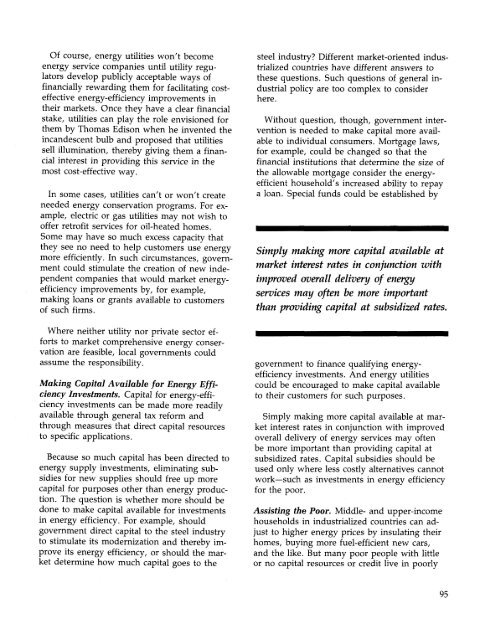ENERGY FOR A SUSTAINABLE WORLD - World Resources Institute
ENERGY FOR A SUSTAINABLE WORLD - World Resources Institute
ENERGY FOR A SUSTAINABLE WORLD - World Resources Institute
You also want an ePaper? Increase the reach of your titles
YUMPU automatically turns print PDFs into web optimized ePapers that Google loves.
Of course, energy utilities won't become<br />
energy service companies until utility regulators<br />
develop publicly acceptable ways of<br />
financially rewarding them for facilitating costeffective<br />
energy-efficiency improvements in<br />
their markets. Once they have a clear financial<br />
stake, utilities can play the role envisioned for<br />
them by Thomas Edison when he invented the<br />
incandescent bulb and proposed that utilities<br />
sell illumination, thereby giving them a financial<br />
interest in providing this service in the<br />
most cost-effective way.<br />
In some cases, utilities can't or won't create<br />
needed energy conservation programs. For example,<br />
electric or gas utilities may not wish to<br />
offer retrofit services for oil-heated homes.<br />
Some may have so much excess capacity that<br />
they see no need to help customers use energy<br />
more efficiently. In such circumstances, government<br />
could stimulate the creation of new independent<br />
companies that would market energyefficiency<br />
improvements by, for example,<br />
making loans or grants available to customers<br />
of such firms.<br />
Where neither utility nor private sector efforts<br />
to market comprehensive energy conservation<br />
are feasible, local governments could<br />
assume the responsibility.<br />
Making Capital Available for Energy Efficiency<br />
Investments. Capital for energy-efficiency<br />
investments can be made more readily<br />
available through general tax reform and<br />
through measures that direct capital resources<br />
to specific applications.<br />
Because so much capital has been directed to<br />
energy supply investments, eliminating subsidies<br />
for new supplies should free up more<br />
capital for purposes other than energy production.<br />
The question is whether more should be<br />
done to make capital available for investments<br />
in energy efficiency. For example, should<br />
government direct capital to the steel industry<br />
to stimulate its modernization and thereby improve<br />
its energy efficiency, or should the market<br />
determine how much capital goes to the<br />
steel industry? Different market-oriented industrialized<br />
countries have different answers to<br />
these questions. Such questions of general industrial<br />
policy are too complex to consider<br />
here.<br />
Without question, though, government intervention<br />
is needed to make capital more available<br />
to individual consumers. Mortgage laws,<br />
for example, could be changed so that the<br />
financial institutions that determine the size of<br />
the allowable mortgage consider the energyefficient<br />
household's increased ability to repay<br />
a loan. Special funds could be established by<br />
Simply making more capital available at<br />
market interest rates in conjunction with<br />
improved overall delivery of energy<br />
services may open be more important<br />
than providing capital at subsidized rates.<br />
government to finance qualifying energyefficiency<br />
investments. And energy utilities<br />
could be encouraged to make capital available<br />
to their customers for such purposes.<br />
Simply making more capital available at market<br />
interest rates in conjunction with improved<br />
overall delivery of energy services may often<br />
be more important than providing capital at<br />
subsidized rates. Capital subsidies should be<br />
used only where less costly alternatives cannot<br />
work—such as investments in energy efficiency<br />
for the poor.<br />
Assisting the Poor. Middle- and upper-income<br />
households in industrialized countries can adjust<br />
to higher energy prices by insulating their<br />
homes, buying more fuel-efficient new cars,<br />
and the like. But many poor people with little<br />
or no capital resources or credit live in poorly<br />
95

















